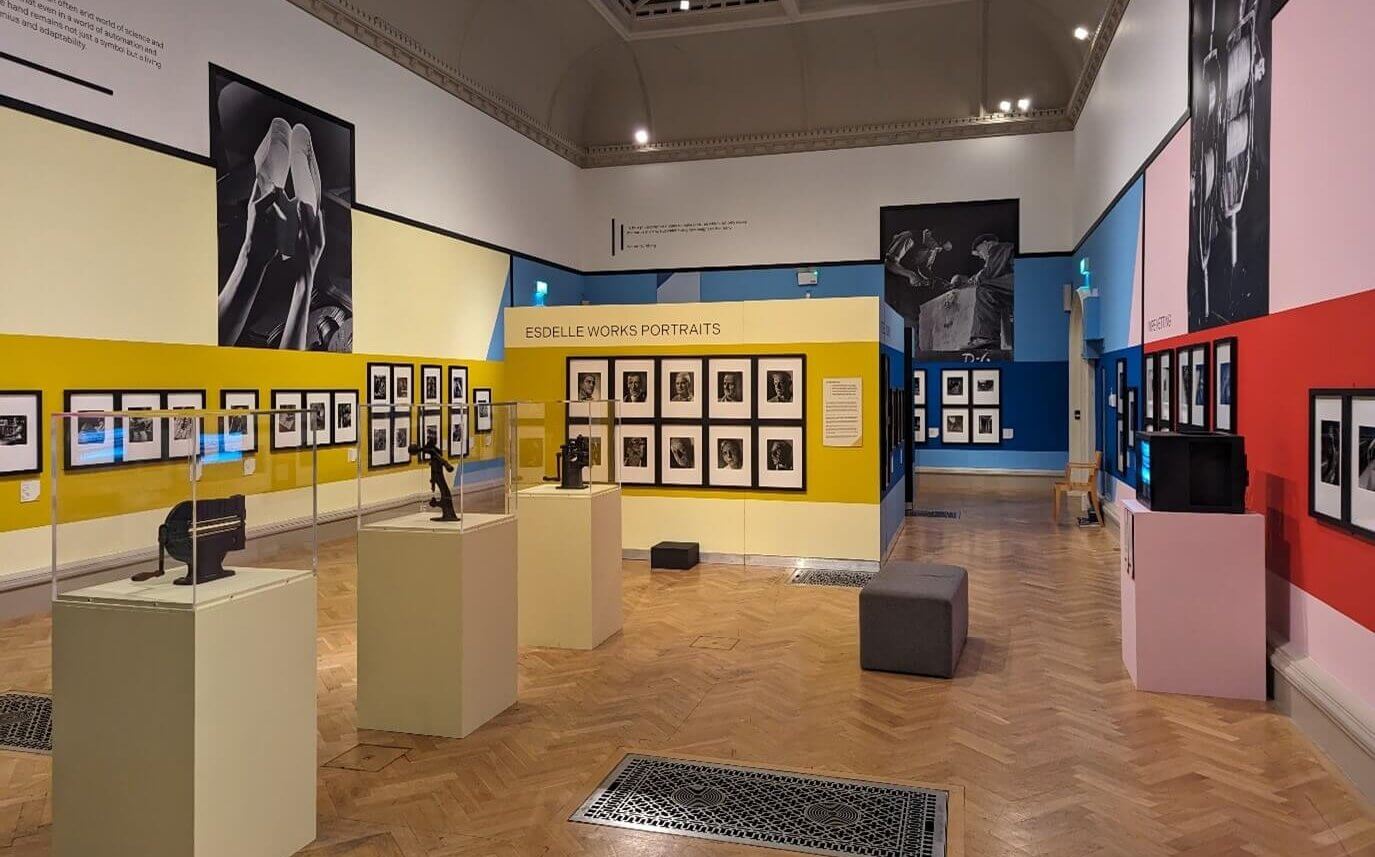
Graduate Intern, Ben Campbell, explores the potential for archive film to enrich exhibitions via a case study of the Norwich Works exhibition.
Norwich Works: The Industrial Photography of Walter & Rita Nurnberg ran from October 2023 until April 2024 at Norwich Castle Museum & Art Gallery. The exhibition was a partnership between Norfolk Museums Service, The University of East Anglia, Norfolk Record Office and The East Anglian Film Archive.
A striking exhibition at Norwich Castle Museum, Norwich Works: The Industrial Photography of Walter and Rita Nurnberg, included four dynamic and newly digitised films from the East Anglian Film Archive. Surrounded by the work of the Nurnbergs, these films gave a longer glimpse into the reality the couple captured and the post-war industrial history of Norwich.
Curated by Dr Nick Warr with contributions from Dr Simon Dell and Elizabeth Elmore, the exhibition was the first ever of the Nurnbergs’ Norwich photographs. It touched many hearts. Margaret Richardson, depicted making marzipan fourrés in 1958 as the main subject of one of the photographs, even visited to see Nurnberg’s photograph of her, displayed in an enlarged form.
Rita and Walter Nurnberg
Husband and wife Walter Nunberg OBE and Rita Nurnberg used carefully orchestrated photographic composition, strong lighting techniques and processing in their photography. From 1948 to 1961, they created a stunning compendium of Bauhaus and New Objectivity-style photographs. The couple captured the patterns of industry in a way that truly catches the eye.
After fleeing Nazi Germany in the 1930s, the Nurnbergs found refuge in Britain. Walter became a part-time teacher at the Reimann School, his previous place of education which had also moved from Berlin to London. There, under the tutelage of Bauhaus student Werner Graeff, he had learned the New Objectivity style and developed his approach to lighting and technique, endeavouring to relay his skills to others.
Rita herself had been born in Fulham in 1914, though lived in Germany during her childhood. After the war she returned to England and began working for Gee & Watson, a commercial photography studio where she began to hone her skills as a photographer and graphic designer. Walter lodged with her parents when he moved to Finchley in 1934, and they began working together, marrying in 1941.
Nurnberg captured photographs across the country, eventually cropping up in Norwich to portray our historic industry. Photographs of shoemaking at Edwards and Holmes’ Esdelle Works, steel construction, woodworking, and wire netting at Boulton & Paul’s Riverside Works, and sweet-making at Mackintosh-Caley’s Chapelfield Works formed the fabric of the exhibition in Norwich Castle. The exhibition acknowledges Rita Nurnberg’s vital involvement in the creation of the photographs which had previously been overlooked.
What was Nurnberg’s ‘reality’?
“Photography is the herald of Reality – a Reality to be found not only in the material aspect of life, but also in our spiritual experience. I, as a photographer, have thus to do two things: to make others see what I see; and make those who understand my language share my emotional and intellectual attitude to life.” — Walter Nurnberg, 1951
Nurnberg paid great attention to the idea of ‘reality’. Dr Warr says that Nurnberg tried to capture the reality of the individual and moments of creation. “It’s when Nurnberg is waiting for the image to show up on his screen and he’s waiting for it all to come together and he’s doing the lights, and he hits the shot, it’s that moment when he realises it’s right. He’s photographing the person making the sweets in the moment when they go, ‘yeah, that’s finished’. So, it’s the reality of that moment of ‘I’ve done something,’ or ‘I’ve made something.’”
The films in the exhibition offered a different perspective on ‘reality’. They stripped back his highly orchestrated glamorous Bauhaus look from the factories to reveal a new angle of Norwich’s history. Residents of Norwich could use the films alongside their own memories and their recent experiences of Norwich fully place themselves within Nurnberg’s incredible work.

A retro television screen shows archive footage as part of Norwich Works: The Industrial Photography of Walter and Rita Nurnberg, Norwich Castle Museum & Art Gallery, 2024. Photo by Ben Campbell.
Four fascinating films
Woven into this fabric, the East Anglian Film Archive worked with Dr Warr to display four films, three of which dated to the early 1950s, around the same time that the photos in the exhibition were taken. They were each carefully placed around the exhibition, near to the photographs most relevant to them.
Cat. 6822 “Works and Office” (late 1950) depicts a stack of large steel beams being moved along the banks of the river Wensum from the Boulton & Paul depot to the engineering works at Thorpe Yard. It was displayed along with Cat. 1635 “Barnard’s Wire Netting Factory” (1950) which shows the close-up creation of large spools of wire netting on looms at Barnards Factory. The close-ups of the netting give the film a modernist, avant-garde feel, evoking Nurnberg’s work. With these films, Warr says, they wanted to use these films to “set the scene” in the exhibition for “what it was like on a day-to-day level”.
Intriguingly, Cat. 908 “Car Trip Through Norwich” (1950) stood out from the industry-focused nature of the rest of the exhibition, giving a wider look at post-war Norwich from the perspective of a police car’s hood. It took visitors on seven short car journeys, passing by the memorable landmarks of the city. Some of the buildings are no longer present today, and multiple buildings appear in the film as bombed-out shells.
Dr Warr states that the car trip, an “oddity” in the East Anglian Film Archive’s collection, was notably the most popular film in the exhibition. He decided to place the film as a “phantom ride” in the centre of the exhibition, intending to evoke the feeling of a car ride itself. Dr Warr was delighted that the film extended visits to the exhibition significantly, with some visitors watching the film for its full quarter-hour runtime. It altered the pacing of visits, allowing for much greater immersion.
Cat. 1309 “Nestles Rowntree” (1996) stands out again as a much more recent film by Roger Hewins. It depicts the Nestle Rowntree factory and is narrated by a selection of workers there who are on their first day, depicting the creation of Yorkies, Rolo Easter eggs, Caramac bars, and Munchies.
This film worked in an artistically subtle way in the context of the exhibition. Placed at the end of the exhibition, it paradoxically evoked the idea of new beginnings. Dr Warr has said that sound design was a major factor in deciding to include this film, as he carefully chose to allow its sounds to spill out of the corner of the exhibition in which it plays. The film also helped present Norwich Works as primarily an exhibition of photography and art, as it stands as a strong piece of filmmaking in its own right.
During Hewins’ film, one worker predicts that in the future the factory will be gone. He hopes that a lottery winner might revive Caley’s factory someday and says that the factory “is a part of the city’s history.” This final film is intentionally the only mention in the exhibition of the closure of any of the factories, says Dr Warr. He wanted the exhibition to portray a positive outlook on the city’s history. In the same way, he says that the exhibition’s title itself, Norwich Works, was chosen purposefully to emphasise that industry is still important to the city.
The Changing Face of Norwich
The EAFA also held an event at Norwich Castle, The Changing Face of Norwich, presented by Dr Warr himself. The event presented films ranging from the 1970s redevelopment of Anglia Square to the 1990s construction of the Postwick viaduct.
While Nurnberg’s photographs of Norwich and the films presented at the exhibition may have shown British industry at its peak, this event took viewers through the period in which that industry declined, and the changes that reverberated through the city. These changes challenged Nurnberg’s later work as automation began to strip back the “human touch” of industry upon which he had previously placed such emphasis.
So, why include archive film in exhibitions?
Including archive film, then, provides a cost-effective yet powerful method of enhancing interpretation for exhibitions. According to Charlie Barr, founding director of Studio MB in Museums Journal, “Technology is playing a central role in exciting developments, but more important is the change of emphasis in how and why stories are being told, and how and why the collections are being used to tell these stories. The shift in narratives to focus on human stories and narratives with empathy, changing context and fresh eyes is also something that has created a need for new approaches to storytelling.”
The Norwich Works exhibition is a story of collaboration. As Dr Warr says, “The museum can’t tell the whole story, the Record Office can’t tell the whole story, the Heritage Centre can’t tell the whole story. But collectively, they fit in together to tell a broader story about Norwich.”
Find out more about the project
Ben Campbell, EAFA Graduate Intern, shares a personal reflection on this case study project.
Header image: Inside the Norwich Works exhibition at Norwich Castle Museum & Art Gallery. Photo by Ben Campbell.



